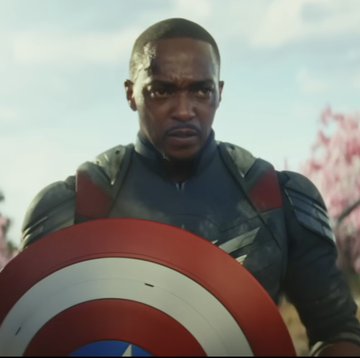Not since Silence of the Lambs swept the six biggest awards at the 1992 Oscars have cannibals had a moment like they've had this year. Cannibals are charming horror villains, Ryan Murphy’s latest true crime muse, and now, they're just a couple of teens trying to cope in Ronald Reagan’s America.
That last bit of cannibaltent, Luca Guadagnino’s Bones and All, may very well be the most scrumptious of them all. (No appetite for cannibal puns? Bite me.) In theaters this Friday, the film adaptation of Camille DeAngelis’s 2015 YA novel sees Guadagnino diverge from past portrayals of people-eating, treating cannibals with the utmost compassion—and yes, a bit of titillation. In the Call Me By Your Name director's delicate hands, they aren't monsters, but complicated, varied people with a rather unfortunate compulsion.
Bones and All introduces us to 18-year-old Maren (Taylor Russell), whose father (André Holland, superb as ever) abandons her, leaving only a small wad of cash, her birth certificate, and a cassette recording explaining his decision. You know, the whole cannibal thing. Maren boards a Greyhound and sets out in search of her mother, watching the verdant trees blur out the window as she listens, in bits and pieces, to her father recounting her story.
During the journey, Maren meets several other cannibals—since there are, apparently, “Not lots. But more than you think.” The first of this unsavory bunch, Sully (Mark Rylance, quickly becoming cinema's go-to oddball), is the sort of character parents warn their children about. He wears a derby hat with a big feather in it and refers to himself in the third person. Wary as Maren is of him, she joins him for a meal, because a stranger’s promise of flesh proves more irresistible than candy. In their short time together, he teaches her how to use her nose to sniff out a dying body, or other eaters.
Though Bones and All doesn't employ Smell-O-Vision, thank god, Guadagnino’s attention to detail is so masterful that you'll swear you got a whiff of something metallic. From its opening shot of high schoolers’ artworks of the local Virginia landscape, Bones and All dwells on textures: bumps on paper, dirt on walls, rust on a pick-up truck, flies buzzing after a meal. The 1980s were a more tactile time, and Guadagnino’s backroads Americana version of the decade transcends its rampant clichés. There are scrunchies and bad sweaters, sure, but he doesn’t call attention to them—placing greater emphasis on timeless artifacts, like a grandmother’s doll collection or the sprinkles sliding down an ice cream cone. The director also, mercifully, eschews the smoky exercise video patina that so many shows and movies use as cheap shorthand.
Actually, if not for the Reagan bumper stickers and lack of iPhones, you might sometimes forget that Bones and All doesn't take place in 2022. If there’s anything that occasionally removes us from Guadagnino’s meticulous world, it’s not the dashes of YA melodrama or even the embellished blood stains, but our protagonists’ Gen Z auras. Shortly after Maren leaves Sully, she meets and falls for Lee (Timothée Chalamet), a sexually fluid cannibal with, seemingly, a few years of experience on her. Between Maren's ill-cropped bangs, Lee's dyed-red mullet, and a wardrobe rich in frills and ripped denim, the two A24 darlings are more modern hipsters than ‘80s outcasts.
Which is fine, for the most part. Chalamet, in particular, isn’t here to disappear into the role of Lee; he’s here to elevate it. Really, it’s a part that a young Nic Cage was born to play. Though Chalamet doesn’t have that level of electric eccentricity, he does have his own compelling brand of skinny boy swagger—and the required androgyny to boot. He slithers, swoops, and hunches, deploying his wiry frame like a slingshot. When we first meet Lee, he’s on the offensive, sticking up to a man harassing a woman in a supermarket with dry, hammy bluster. “Hey, you’re out of control, buddy,” he says, like someone looking for an excuse to turn a run-of-the-mill jerk into a very special dinner. It’s one of several straightly-delivered lines that will produce a laugh; the best, though, comes later, when he describes a time when, “I ate him right the fuck up.”
But as much campy fun as Chalamet and co. have, the film never loses sight of cannibalism’s violent realities. Guadagnino underscores each victim’s humanity, often taking us inside their homes to reveal personal belongings and photos, alluding to the presence of families and inner lives. The pain Maren and Lee have the potential to inflict is plain enough that Maren can’t run from it, no matter how far the pair drive. If only they wanted to fuck peaches, right?
Maren’s war with her own bodily urges is the film’s primary source of tension—and one that’s intriguing dramatically, if potentially thorny, metaphorically. (Despite the time and place the film is set, Guadagnino has denied that Bones and All is an AIDS allegory). But it’s hard not to give Guadagnino the benefit of the doubt, considering the empathy he extends to each character. Even Sully, a pure punchline in other hands, is plagued with loneliness and bursting with anguish.
Ultimately, the cannibalism of it all threatens to consume Bones and All, which is, at its core, a beautiful road movie. Guadagnino may be a foreigner on American soil, but he (with help from cinematographer Arseni Khachaturan) has a special knack for finding and photographing the nation’s vibrant byways, scenic vistas, and colorful amusements. Most of the journey takes place throughout one summer, and the gruesome feasting is juxtaposed with the perfectly blue-pink sunsets and tall, green cornhusks. Everything that isn’t dying is fully alive and buzzing. At a time when many films have bunkered down in contained locations due to safety concerns, the sprawl of Bones and All is a breath of fresh air. While, no, the film didn’t leave me hungry (I swear!), it did give me a different yearning: to get outside and drive.












